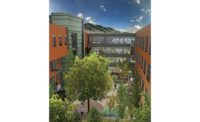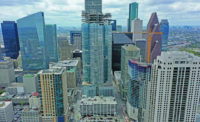Lasers With a Twist Capture Lateral Distortion


















Before barging and lifting two halves of a 2,650-ton truss assembly for the superstructure of the $1.2 billion Huey P. Long Bridge widening, the contractor wanted to have a way to monitor how the steel was reacting to all of the jostling.
MTI, a joint venture of Massman Construction Co., Kansas City, Mo., Traylor Bros. Inc., Evansville, Ind. and IHI Inc., New York, NY, hired Applied Geomechanics Inc. San Francisco to develop a monitoring system that would keep the contractor apprised of stresses to the truss in real time.
“As they lift, think of two parallel pieces of paper,” says Thomas Weinmann, AGI’s structural health monitoring group manager. “If everything goes well, they will remain flat. You don’t want them to bend too much.”
Weinmann says that, to his knowledge, no truss this large has been lifted before, definitely not by lifting the two halves separately. Consequently, the contractor didn’t have a proven, reliable method to monitor stresses during transporting and erection.
AGI devised a system of tilt meters and long distance laser deflection devices to measure out-of-plane distortion on the truss. Tilt meters are “highly accurate” and often used to monitor building tilts, Weinmann says, but “this is an innovative way we are using distance lasers to measure deflection.”
Long-distance displacement lasers are positioned to shoot at 45-degree targets (as opposed to the typical, perpendicular) on various locations on the truss. “If it shoots to a perpendicular surface, as the object moves closer or farther away, we capture that changing distance measurement,” Weinmann says. “With the target at a 45-degree angle, if they move left or right (deflection), the laser sits at a closer or farther pint on the 45-degree target, thinking a distance has changed. The distance has not changed. The deflection has changed.”
When MTI first approached AGI, the subcontractor shopped for an existing system, but couldn’t find one. “By being creative and utilizing simple geometry,” Weinmann says, AGI came up with a concept that worked. On June 18, the day the truss was barged into position, AGI set up a data collection system on the bridge pier, linked by a wireless network to the instruments on the truss as it rose through the air. The system included two laptop computers that captured data in real time and displayed graphic representations of out-of-plane distortions.
“The system worked good,” says Steve Underwood, MTI project manager. “It allowed us to keep a close monitor on everything the truss was doing.”
Adds Weinmann, “I’ve been in this business 30 years, and this is probably one of the most exciting projects I’ve ever worked on.”













